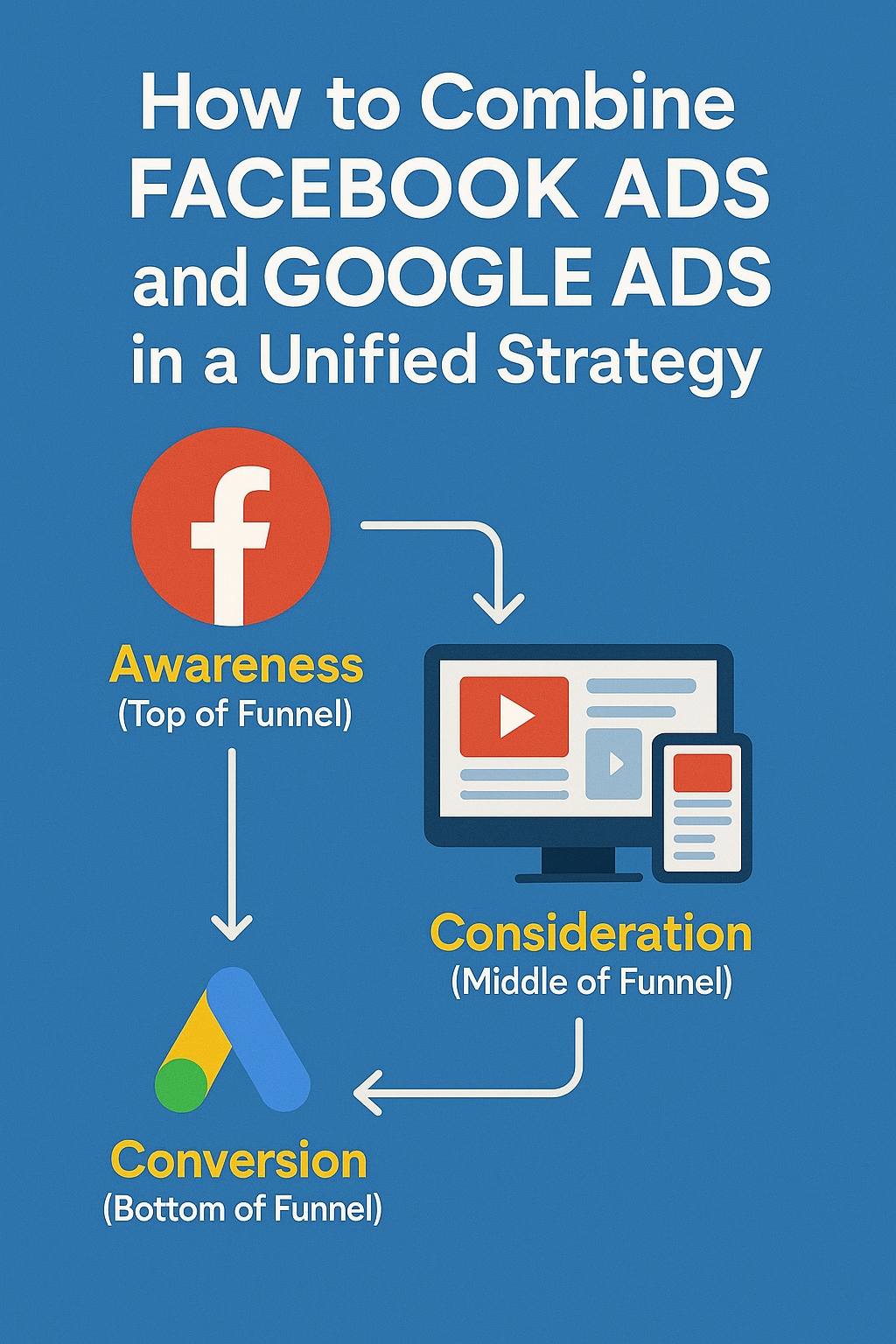Most businesses — and even many traffic managers — choose between Facebook Ads and Google Ads as if they were competing platforms.
But here’s the truth:
If used together, they become a powerful duo that drives better results at every stage of the customer journey.
In this article, you’ll learn how to combine Facebook Ads and Google Ads into a cohesive traffic strategy, with each platform playing its role to attract, nurture, and convert your audience.
Why Use Both Platforms Together?
Each platform serves a different purpose:
✅ Facebook Ads:
- Interruption-based
- Great for discovery and storytelling
- Highly visual and emotionally engaging
- Ideal for brand awareness, retargeting, and social proof
✅ Google Ads:
- Intent-based
- Targets users who are searching for your product or service
- Perfect for capturing demand and closing sales
- Works well for local services, e-commerce, and high-intent queries
Combining both gives you full-funnel coverage, from attention to conversion.
The 3 Stages of a Unified Funnel
Let’s look at how to structure a funnel that uses both platforms effectively:
🔹 Stage 1: Awareness (Top of Funnel)
Goal: Get attention and generate interest
Best tool: Facebook Ads
Strategy:
- Target cold audiences based on interests or lookalikes
- Use videos, carousels, and stories to introduce your offer
- Drive clicks to a blog, lead magnet, or product teaser
Examples:
- A 30-second video ad on Facebook showing a skincare routine
- Carousel showing features of a digital planner
- Instagram Story with swipe-up to a free guide
💡 Track interactions using Meta Pixel and build engagement audiences.
🔹 Stage 2: Consideration (Middle of Funnel)
Goal: Nurture leads and build trust
Best tools: Facebook Ads + Google Display + YouTube Ads
Strategy:
- Retarget website visitors, video viewers, or lead magnet downloaders
- Share case studies, testimonials, and product demonstrations
- Drive traffic to a landing page or webinar
Examples:
- Facebook ad showing a client transformation
- Google Display ad showing your product on relevant blogs
- YouTube video explaining how your service works
💡 Build custom audiences on both platforms based on mid-funnel behavior.
🔹 Stage 3: Conversion (Bottom of Funnel)
Goal: Drive sales or sign-ups
Best tool: Google Search Ads + Facebook Retargeting
Strategy:
- Use Google Search Ads to target bottom-funnel keywords (e.g. “buy wireless headphones”)
- Retarget warm users with Facebook Ads offering urgency, discounts, or bonuses
- Show cart abandonment ads to users who started checkout
Examples:
- Google Ad triggered by “best fitness app for beginners”
- Facebook Ad offering 20% off to recent website visitors
- Instagram Ad with testimonial from a past client
💡 Use exact match keywords in Google, and dynamic product ads on Facebook.
Real-World Example: Combining Facebook and Google
Let’s say you’re helping an online course creator.
Facebook Ads:
- Top of funnel: Video ad with course teaser → opt-in for a free webinar
- Retargeting: Show testimonials to those who visited the webinar page
Google Ads:
- Search campaign targeting keywords like “online productivity course”
- Display campaign to retarget people who visited the checkout page
Result:
Facebook creates demand, Google captures intent, and both platforms feed each other.
Budget Allocation Strategy
Start with 70/30, then adjust:
| Funnel Stage | Platform | % of Budget |
|---|---|---|
| Awareness | Facebook/Instagram | 50–70% |
| Consideration | Facebook + Display | 10–20% |
| Conversion | Google Search + FB retargeting | 20–40% |
Always watch performance — and shift budget to the platform delivering the best cost per result.
How to Manage Cross-Platform Tracking
To optimize properly, you need accurate data from both sides.
Tools:
- Google Tag Manager: Add Facebook Pixel + Google Tags
- Google Analytics 4: Compare performance across channels
- UTM Parameters: Track specific ads in GA4
- Looker Studio: Build dashboards that pull from both platforms
💡 Track conversions at each stage to see where users drop off or complete the journey.
Tips for Success When Using Both Platforms
- Align messaging: Keep the offer and branding consistent across both
- Use retargeting loops: Facebook to Google and vice versa
- Schedule campaigns: Let Facebook warm the audience, then run Google Search
- Test audience crossover: Do people who clicked your Google Ads engage with your Facebook offers?
Final Thoughts: Synergy Beats Silos
You don’t need to choose between Facebook Ads and Google Ads.
You need to learn how they work together.
When you combine interruption-based and intent-based traffic in a single strategy, you get:
- More visibility
- Higher conversions
- Stronger brand presence
- Better ROI across the board
That’s how pro traffic managers build systems — not just campaigns.
